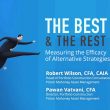by Wylie Tollette, Franklin Templeton Investments
Listen to our latest “Talking Markets” podcast.
Transcript
Stephen Dover: So, at the end of last year, rolling into this year, you wrote and said this year, 2022, is going to be a year of volatility both in the economy and markets. And here we are, and that’s where a lot of questions are. Give us some framework of the volatility we’re seeing and what you see ahead.
Wylie Tollette: I always like to think of the capital markets and stock markets in particular really being affected by two big things. The first: fundamentals, data, inflation, interest rates, corporate profits and earnings. The other thing they’re affected by is human behavior, and because of the human behavior element, they tend to go further. They’re like a pendulum. They go further on the positive side when things are looking good, they go further than they really should. And then they tend to go more negative than they really should on the negative side. They spend almost no time at what might be perceived as a perfectly rational or efficient point. And last year, we saw things go too far in the positive direction with the reopening trade, and we saw tech stocks kind of get way beyond their earnings expectations, if they even had earnings. We saw a lot of different assets really rise—Bitcoin comes to mind. And now we’re seeing the tide go out the other direction. And once again, we expect that pendulum to go a little too far on the negative direction. I don’t think we’re all the way there yet, but it’s expected, this volatility is to be expected when you have so many different economic elements sort of in flux right now in the global marketplace.
Stephen Dover: So, Wylie, I mean, we just haven’t seen volatility as we’ve seen right now. We see volatility in equities, of course, but volatility in fixed income is even higher than equity. So traditional bonds helping out when equities are down doesn’t seem to be working right now.
Wylie Tollette: Yeah, that’s exactly right, Stephen. And you and I are both blessed to be old enough to remember the last time we saw fixed income volatility approach equity market volatility, it was back in the late 1970s and early 1980s. We were both just kids of course. But it was really the last time, and it’s to be expected when inflation rates climb, bond prices and yields are a component both of the yields that the government can help determine, like short-term yields, fed fund rates, and inflation expectations, longer-term inflation expectations. So, because bond prices and yields have these multifactor components, we’re seeing the inflation expectations be quite volatile and basically going up recently. That’s driving bond market volatility, and the Fed [US Federal Reserve], which has for really the last 15 years in particular, but perhaps even longer than that, been very supportive of financial markets in terms of lowering rates overall. We’re seeing the Fed shift direction. So lately, they’ve been raising rates of course. So, both elements of bond prices have been volatile and changing. That’s why we’re seeing fixed income sort of lose its status as a diversifier recently. Last time we saw that, again, back sort of mid-1990s for a short stretch, 1994, 1995, and then prior to that, in a dramatic way, in the mid-1980s. So, I think investors, again, need to think about adding additional elements of diversification beyond fixed income. Fixed income has been a great diversifier for equity risk for roughly the last 35 years, but in environments like this, you need other things to diversify your portfolio.
Stephen Dover: So, Wylie, maybe one opportunity is cash right now, which actually has a little yield on it, but if we’re going to diversify between equities and fixed income, what areas might we be looking at?
Wylie Tollette: Yeah, cash is a great option. In fact, keeping a little bit of liquidity is not a bad thing at all. You just have to keep in mind that cash, with inflation running right now at 8%, it’s losing purchasing power every day. And it’s losing more purchasing power when inflation is high than when inflation is low, but it has a stable price, which can be a very comforting thing when markets are volatile. I would say that the first thing that many investors look to diversify into in periods of high inflation and rising rates are real assets and real estate in particular. Many retail investors are diversified in real estate through the ownership of a home, but if you’re a renter, then there’s other ways to diversify into real estate. REITs [real estate investment trusts] are an example, a public market example of diversified real estate exposure. And then, of course, private real estate, which tends to not be quite as volatile, just because the transaction, timing is trickier and there’s less liquidity, but also tends to be a good diversifier for inflation and a bit of a hedge against inflation due to the fact that most rental contracts in commercial real estate are tied to inflation. So, it has kind of a built-in natural hedge. The other area to look at for diversification at this point are other types of real assets, commodities. They’ve had a spectacular run lately with oil prices climbing, gold climbing, the Ukraine war affecting the price of many food stuffs that get built into commodities. So, the trick with commodities is, we would advocate for sort of a periodic allocation to commodities, but perhaps not a strategic allocation, basically because commodities don’t necessarily have a natural rate of return. Their natural rate of return is actually slightly negative. So, they’re a good thing to have as inflation is climbing, but right now, we think the inflation—that train— may have left the station.
Stephen Dover: Well, right now of course there’s a lot of anxiety and probably all of us naturally feel like we should do something. You have a long-term perspective, but should we just be calm or should we shift our portfolios right now?
Wylie Tollette: I do think there’s going to be an opportunity to rebalance into markets that have had significant wind taken out of their sails. I think it might be still a bit early to do that, but there is going to be a time where reinvesting in stock markets that have been beaten down will be the smart move. I think that time, as I said, is probably still a few months off. So in the meantime, I know that people feel a motivation to do something when they look at markets being this volatile. I personally would advocate for taking a deep breath as a first step. Think about the overall risk positioning of your portfolio and to be very cautious about overreacting or overthinking this, because I think there’s still a few more cycles of inflation worry, a few more, sort of, bounces that we’re going to see in stock markets before it starts to be time to reinvest. And then, when it is time to reinvest and rebalance those portfolios back to your longer-term strategic asset allocation, which should always be sort of your guiding star, your north star, we would advocate investing in what we would call the quality factor. So, quality factor is the factor that tends to outperform in markets like this. Quality stocks usually are profitable, have good cash flow, have good balance sheets. That is, as opposed to stocks that may have little or no earnings, you know, where most of their earnings are likely in the future or very speculative names, quality stocks, they tend to do well and they tend to also react less badly if there’s intervening surprises once that rebalance happens. They tend to be a bit more stable. So, we think that’s kind of the first step to step back into stock markets after this drawdown that we’ve seen.
Stephen Dover: Wylie, you mentioned cryptocurrencies. Any thoughts about that asset category?
Wylie Tollette: I would say that I personally am very, very cautious about cryptocurrency. I think blockchain, as a technology and as a capability, has huge promise at basically making currently non fungible or non-tradeable assets tradeable in the future. I think stablecoins backed by governments or backed by real collateral eventually will be, could be, a meaningful part of investors’ portfolios. But many of the existing cryptos that are out there today really are kind of the rule of the next buyer is the source of the value versus any underlying economic driver. So, like I mentioned earlier, I always look for investments that have a fundamental economic engine behind them. Bonds have a contract to pay you interest. Equities have the promise of generating profits over the long term. That’s the economic driver. Commodities, on the other hand, in many cases, the source of a return on a commodity is the ability to sell it to the next logical buyer and with the hope that that next logical buyer is going to buy it at a higher price. Same with cryptocurrencies. And so, if you’re invested in cryptocurrencies, you have to count on the fact that then next buyer’s going to be there, and that he’s going to be willing to pay a higher price than you bought it for. That is not necessarily a fundamental economic driver for returns. So, until we see governments step in and actually provide some backing for those cryptocurrencies, I remain very skeptical.
Stephen Dover: Thanks, Wylie. That’s Wylie Tollette from Franklin Templeton Investment Solutions.
Host: And thank you for listening to this episode of Talking Markets with Franklin Templeton. If you’d like to hear more, visit our archive of previous episodes and subscribe on iTunes, Google Play, Spotify, or just about anywhere else you get your podcasts. And we hope you’ll join us next time, when we uncover more insights from our on the ground investment professionals.
Important Legal Information
This material reflects the analysis and opinions of the speakers as of May 12, 2022 and may differ from the opinions of portfolio managers, investment teams or platforms at Franklin Templeton. It is intended to be of general interest only and should not be construed as individual investment advice or a recommendation or solicitation to buy, sell or hold any security or to adopt any investment strategy. It does not constitute legal or tax advice.
The views expressed are those of the speakers and the comments, opinions and analyses are rendered as of the date of this podcast and may change without notice. The information provided in this material is not intended as a complete analysis of every material fact regarding any country, region, market, industry, security or strategy. Statements of fact are from sources considered reliable, but no representation or warranty is made as to their completeness or accuracy.
What Are the Risks?
All investments involve risks, including possible loss of principal. The value of investments can go down as well as up, and investors may not get back the full amount invested. Stock prices fluctuate, sometimes rapidly and dramatically, due to factors affecting individual companies, particular industries or sectors, or general market conditions. Investments in fast-growing industries like the technology and healthcare sectors (which have historically been volatile) could result in increased price fluctuation, especially over the short term, due to the rapid pace of product change and development and changes in government regulation of companies emphasizing scientific or technological advancement or regulatory approval for new drugs and medical instruments. Bond prices generally move in the opposite direction of interest rates. Thus, as the prices of bonds adjust to a rise in interest rates, the share price may decline. Investments in foreign securities involve special risks including currency fluctuations, economic instability and political developments. Commodities and currencies contain heightened risk that include market, political, regulatory, and natural conditions and may not be suitable for all investors.
Buying and using blockchain-enabled digital currency carries risks, including the loss of principal. Speculative trading in bitcoins and other forms of cryptocurrencies, many of which have exhibited extreme price volatility, carries significant risk. Among other risks, interactions with companies claiming to offer cryptocurrency payment platforms or other cryptocurrency-related products and services may expose users to fraud. Blockchain technology is a new and relatively untested technology and may never be implemented to a scale that provides identifiable benefits. Investing in cryptocurrencies and ICOs is highly speculative and an investor can lose the entire amount of their investment. If a cryptocurrency is deemed a security, it may be deemed to violate federal securities laws. There may be a limited or no secondary market for cryptocurrencies.
The risks associated with a real estate strategy include, but are not limited to various risks inherent in the ownership of real estate property, such as fluctuations in lease occupancy rates and operating expenses, variations in rental schedules, which in turn may be adversely affected by general and local economic conditions, the supply and demand for real estate properties, zoning laws, rent control laws, real property taxes, the availability and costs of financing, environmental laws, and uninsured losses (generally from catastrophic events such as earthquakes, floods and wars).
Any companies and/or case studies referenced herein are used solely for illustrative purposes; any investment may or may not be currently held by any portfolio advised by Franklin Templeton. The information provided is not a recommendation or individual investment advice for any particular security, strategy, or investment product and is not an indication of the trading intent of any Franklin Templeton managed portfolio.
There is no assurance that any estimate, forecast or projection will be realized.
Diversification does not guarantee a profit or protect against a loss.
Past performance does not guarantee future results.
Data from third party sources may have been used in the preparation of this material and Franklin Templeton (“FT”) has not independently verified, validated or audited such data. FT accepts no liability whatsoever for any loss arising from use of this information and reliance upon the comments, opinions and analyses in the material is at the sole discretion of the user.
Products, services and information may not be available in all jurisdictions and are offered outside the U.S. by other FT affiliates and/or their distributors as local laws and regulation permits. Please consult your own financial professional for further information on availability of products and services in your jurisdiction.
Issued in the U.S. by Franklin Distributors, LLC. Member FINRA/SIPC, the principal distributor of Franklin Templeton’s U.S. registered products, which are available only in jurisdictions where an offer or solicitation of such products is permitted under applicable laws and regulation. Issued by Franklin Templeton outside of the US.
Please visit www.franklinresources.com to be directed to your local Franklin Templeton website.
Copyright © 2022 Franklin Distributors, LLC. Member FINRA/SIPC. All rights reserved.
This post was first published at the official blog of Franklin Templeton Investments.















